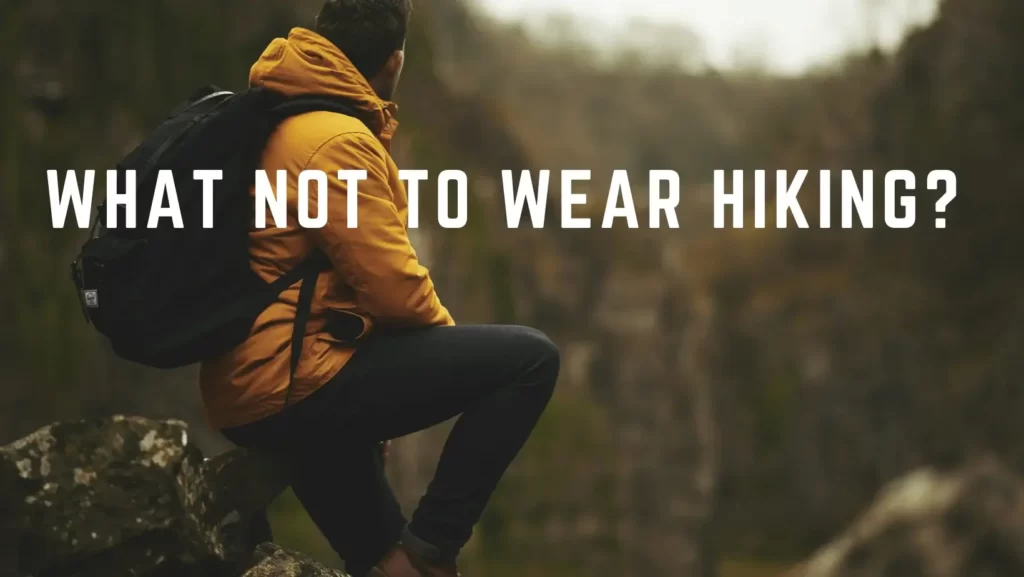What To Wear Hiking

Are you wondering on what to wear hiking adventure that includes comfort, practicality and style.You are at the right place to discover. Opt for moisture-wicking, breathable fabrics like nylon or merino wool to regulate temperature and keep sweat at bay.
Layering is key for fluctuating conditions; start with a moisture-wicking base layer, add insulating mid-layers like fleece or a lightweight down jacket, and top it off with a waterproof and windproof shell.
Choose sturdy, supportive hiking footwear with good traction, such as hiking boots, leather hiking boots or trail shoes. Don’t forget a wide-brimmed hat for sun protection, sunglasses, and consider packing gloves and a beanie for chilly weather. And always bring along a backpack for essentials!
Your Ultimate Guide

When preparing for a hiking adventure, selecting the right clothing is crucial for comfort, protection, and performance. If you are thinking on what to wear hiking women or what to wear hiking men, our guide is for all of you.
Start with a moisture-wicking base layer to keep sweat away from your skin. Consider lightweight, breathable joggers or hiking pants that provide flexibility and protection against abrasions. Opt for synthetic or merino wool materials that dry quickly and resist odors.
Layering is key for adapting to changing weather conditions. Begin with the base layer, adding an insulating mid-layer like a fleece jacket or vest for warmth. Ensure your outer layer is a waterproof and windproof shell to shield against rain and gusty winds. This three-layer system allows you to adjust your clothing as needed, maintaining optimal comfort throughout the hike.
Choose a moisture-wicking, long-sleeved shirt for added sun protection and versatility. For cooler weather, consider convertible pants that can transform into shorts. Invest in quality hiking socks to prevent blisters and ensure proper moisture management. Sturdy, supportive hiking shoes with excellent traction are essential for navigating various terrains.
Accessories play a vital role in enhancing your hiking experience. Protect yourself from the sun with a wide-brimmed hat and UV-blocking sunglasses. Pack a lightweight, compact backpack to carry essentials like water, snacks, a first aid kit, and a map. Depending on the climate, bring a beanie and gloves for warmth.
Always check the weather forecast before heading out and adjust your clothing accordingly. In colder conditions, add more layers, including thermal underwear. In hotter weather, focus on lightweight, breathable clothing and carry a sunblock for exposed skin.
For challenging terrains, gaiters can protect your ankles and lower legs from debris. In snowy conditions, bring waterproof pants and insulated layers. Tailoring your clothing choices to the trail conditions ensures a comfortable and enjoyable hiking experience.
What To Not Wear Hiking?

When venturing into the great outdoors for a hike, certain hiking outfit choices can hinder rather than help your experience. Avoid wearing cotton clothing as it absorbs moisture and takes a long time to dry, increasing the risk of discomfort and even hypothermia in cold or wet conditions. Instead, opt for moisture-wicking fabrics like polyester or merino wool that keep you dry and comfortable.
Avoid wearing ill-fitting or inappropriate hiking footwear such as sneakers or sandals, as they lack the necessary support and traction for navigating rugged terrain. Opt for sturdy hiking boots or trail shoes with good grip to prevent slips and injuries.
When planning a hiking outfit, steer clear of bulky or excessive layers that restrict movement and cause overheating. Instead, opt for a streamlined layering system that allows for easy adjustment as temperatures fluctuate.
Avoid wearing jewelry or accessories with your hiking outfit that could get caught on branches or rocks, posing a safety hazard. Refrain from wearing heavy perfumes or scented products that could attract insects.
Clothing Strategies

When you want to plan your hiking attire but you also want to pick fashionable hiking clothes, consider these strategic clothing choices to ensure comfort, safety, and enjoyment on the trails:
Layering
Adopt a layering system consisting of a moisture-wicking base layer, insulating mid-layers, and a waterproof and windproof outer shell. This allows you to adjust your clothing to changing weather conditions and activity levels.
Moisture Management
Choose clothing made from moisture-wicking materials like polyester or merino wool to keep sweat away from your skin and prevent discomfort and chafing.
Versatility
Opt for versatile clothing pieces such as convertible pants that can easily transition into shorts or jackets with zip-off sleeves, allowing you to adapt to varying temperatures and terrain.
Protection
Prioritize clothing that provides protection against the elements, including sun exposure, rain, wind, and insects. Wear a wide-brimmed hat, sunglasses, and sunscreen for sun protection, and consider lightweight, breathable rain gear for wet conditions.
Comfort and Fit
Select clothing that fits well and allows for a full range of motion. Opt for comfortable hiking pants, avoid tight, restrictive clothing that may cause chafing or discomfort during prolonged activity.
Footwear
Choose sturdy, supportive hiking boots or trail shoes with good traction to provide stability and prevent slips and injuries on uneven terrain.
Best Materials When Going For A Hike

When selecting fabrics for hiking trails, prioritize those that offer moisture-wicking properties, durability, breathability, and quick drying capabilities. Here are some top fabric choices for hiking:
Merino Wool
Merino wool is renowned for its natural moisture-wicking properties, odor resistance, and temperature regulation. It’s soft, breathable, and comfortable against the skin, making it an excellent choice for base layers, socks, and mid-layers.
Synthetic Fabrics (Polyester, Nylon)
Synthetic fabrics like polyester and nylon are lightweight, quick-drying, and highly durable. They excel at wicking moisture away from the skin, keeping you dry and comfortable during intense activity. Look for synthetic blends with added stretch for increased mobility.
Polypropylene
Polypropylene is another synthetic fabric known for its moisture-wicking capabilities. It’s lightweight, hydrophobic, and retains warmth even when wet, making it ideal for base layers in cooler conditions.
Other Waterproof Breathable Membranes
For outer layers, consider fabrics with waterproof and breathable membranes like Gore-Tex. These materials offer protection against rain and wind while allowing moisture vapor to escape, keeping you dry and comfortable in inclement weather.
Cotton Blends (for Warm, Dry Conditions)
While cotton is generally not recommended for hiking trails due to its poor moisture-wicking properties and slow drying time, cotton blends can be suitable for hiking in warm, dry conditions where moisture management is less critical. Look for blends with added synthetic fibers for improved performance.
Rain Protection

For rain protection, prioritize waterproof and breathable fabrics such as Gore-Tex or similar materials for outer layers like jackets and pants. These fabrics effectively repel rain while allowing moisture vapor to escape, keeping you dry from both external precipitation and internal sweat. Look for fully taped seams and water-resistant zippers to prevent water from seeping in.
Sun Protection

For sun protection, choose clothing with built-in UPF (Ultraviolet Protection Factor) ratings, which indicate the level of UV radiation blocked by the fabric. Look for garments labeled with UPF 30 or higher for effective sun protection. Lightweight, breathable fabrics with tight weaves offer better UV protection.
Wear a wide-brimmed hat to shield your face, neck, and ears from the sun’s rays, and opt for sunglasses with UV protection to safeguard your eyes. Apply a broad-spectrum sunscreen with an SPF (Sun Protection Factor) of 30 or higher to any exposed skin, and reapply regularly, especially after sweating or swimming.
Adapt For Each Season

Adapting your fashionable hiking clothes to different seasons ensures comfort and safety throughout the year. Here’s how to adjust your hiking attire for each season:
Summer:
In summer, the hiking trails is great for your health and fitness as it moves the muscles in your body keeping it activated. Wondering what to wear hiking in summer, to make the perfect hiking attire look down:
Lightweight and Breathable Fabrics: Opt for moisture-wicking and breathable materials like nylon, polyester, or merino wool to keep you cool and dry.
Shorts and Short-Sleeved Shirts: Choose lightweight, quick-drying shorts and short-sleeved shirts to stay cool in hot temperatures.
Sun Protection: Wear a wide-brimmed hat, sunglasses with UV protection, and apply sunscreen to exposed skin regularly.
Hydration: Carry plenty of water or a hydration pack to stay hydrated in the heat.
Autumn
Layering: Begin with a moisture-wicking base layer, add insulating mid-layers like fleece or a lightweight down jacket, and top it off with a waterproof and windproof shell for variable weather conditions.
Long Pants and Long-Sleeved Shirts: Wear long pants and long-sleeved shirts to protect against cooler temperatures and potential insect bites.
Rain Gear: Bring waterproof and breathable rain gear to stay dry in unpredictable autumn showers.
Footwear: Consider waterproof hiking shoes or boots to keep your feet dry in wet conditions. Leather hiking boots are a good choice especially when you are on long trails and need comfort and lasting.
Winter
Choosing to hike in water is cool and breezy, thinking on what to wear hiking in winter, this winter apparel guide is all for you:
Insulating Layers: Add thermal base layers and insulating mid-layers like fleece or down jackets to trap heat and stay warm.
Waterproof and Insulated Outerwear: Wear a waterproof and windproof hiking jacket and pants, insulated with down or synthetic insulation for added warmth.
Warm Accessories: Don’t forget gloves, a beanie, and a neck gaiter or scarf to protect exposed areas from cold winds.
Sturdy Footwear: Choose insulated and waterproof hiking shoes with good traction to navigate snow and ice safely.
Spring
Spring is the best season for hiking as the weather is fresh and flowery, there’s not much of a sweat or trembling teeth. Follow the below guide to know what to wear hiking apparel in spring:
Layering: Follow a similar layering system as in autumn, adjusting for slightly warmer temperatures.
Lightweight Rain Gear: Bring a lightweight, packable rain jacket and pants for spring showers.
Convertible Clothing: Consider convertible pants and jackets with zip-off sleeves for versatility in fluctuating temperatures.
Extra Traction: Use hiking poles and consider traction devices for your boots to navigate muddy trails and lingering snow patches.
Layering Strategies

Layering is crucial for hiking to maintain comfort and regulate body temperature. Here are the basic layers to consider:
Base Layer (Next-to-Skin)
Bras and Underwear: Choose moisture-wicking sports bras and underwear made of synthetic materials or merino wool to keep you dry and comfortable.
Socks: Wear moisture-wicking, cushioned hiking socks to prevent blisters and provide support. Consider liner socks for added moisture management.
Shirt: Opt for a moisture-wicking, long-sleeved base layer shirt to regulate temperature and protect against sun exposure.
Mid-Layer (Insulating)
Insulating Bras (Optional): In colder conditions, consider wearing an insulating sports bra or adding an extra layer of warmth.
Midweight Insulating Layer (Optional): Add a midweight fleece or synthetic jacket for extra warmth in cooler temperatures.
Midweight Insulating Bottoms (Optional): Consider wearing midweight base layer bottoms or leggings for additional warmth in colder conditions.
Outer Layer (Protective)
Shell Jacket: Choose a waterproof and windproof shell jacket to protect against rain, wind, and abrasions. Look for features like adjustable hoods and ventilation zippers for added versatility.
Shell Pants (Optional): In wet or windy conditions, wear waterproof and windproof shell pants to keep your lower body dry and protected.
Adjust layers as needed based on the temperature, terrain, and intensity of your hike.
Footwear For Hiking

Choosing the right hiking footwear is essential for a comfortable and safe hiking experience. Here are some considerations when selecting hiking footwear:
Hiking Boots
Hiking boots or leather hiking boots provide ankle support, stability, and protection from rough terrain. Look for boots with sturdy construction, a supportive midsole, and a lugged outsole for traction. Choose waterproof boots with breathable membranes like Gore-Tex for wet conditions. Opt for boots that fit well and feel comfortable from the start, considering factors like toe room and arch support.
Trail Shoes
Trail shoes are lighter and more flexible than hiking boots, ideal for day hikes and less rugged terrain. They offer good traction and support, but may not provide as much ankle stability as boots. Trail shoes are often more breathable than boots, making them suitable for warmer weather.
Hiking Sandals
Hiking sandals are a breathable and lightweight option for warm weather hiking and water crossings. Look for sandals with durable straps, cushioned footbeds, and grippy outsoles for traction on slippery surfaces. Choose sandals with toe protection to prevent stubbing and injury on rocky terrain..
Accessories

Bring essential accessories such as a backpack for carrying water, snacks, a first aid kit, and navigation tools. Consider additional items like gloves, a beanie, and gaiters for extra protection in cold or snowy conditions.
Hat: Wear a lightweight, moisture-wicking hat or cap to shield your face and head from the sun and regulate temperature.
Gloves and Mittens: Bring lightweight gloves or mittens to protect your hands from cold temperatures and wind chill.
Buff or Neck Gaiter: Carry a multifunctional buff or neck gaiter to protect your neck and face from sun, wind, and cold.
Sustainability Features

When considering sustainability while hiking, it’s essential to minimize your environmental impact and promote responsible outdoor practices. Here are some sustainability features to integrate into your hiking experience:
Leave No Trace Principles
Follow the Leave No Trace principles, which include leaving natural areas as you found them, disposing of waste properly, and minimizing campfire impacts.
Reusable Gear and Containers
Use reusable water bottles, food containers, and utensils to reduce single-use plastic waste. Opt for durable and long-lasting hiking gear to minimize the need for frequent replacements.
Packaging Reduction
Choose snacks and food items with minimal packaging to reduce waste on the trail. Repackage bulk items into reusable containers to minimize single-use packaging.
Responsible Waste Disposal
Pack out all trash, including food scraps, and dispose of it properly in designated waste receptacles. Practice proper waste disposal for human waste by digging catholes or using designated toilets.
Sustainable Trail Practices
Stay on designated trails to protect fragile ecosystems and prevent habitat destruction. Avoid trampling vegetation and sensitive areas, especially in alpine and desert environments. Respect wildlife by observing from a distance and avoiding feeding or approaching animals.
Energy and Transportation
Reduce your carbon footprint by carpooling or using public transportation to reach trailheads. Consider offsetting carbon emissions from travel through reputable carbon offset programs.
Support Sustainable Brands
Choose hiking gear and clothing from brands that prioritize sustainability, such as those using eco-friendly materials and ethical manufacturing practices.
Educate and Advocate
Educate yourself and others about the importance of sustainable hiking practices and environmental stewardship. Advocate for the protection of public lands and natural habitats through conservation efforts and policy initiatives.
By integrating these sustainability features into your hiking routine, you can enjoy the outdoors responsibly and contribute to the preservation of natural spaces for future generations.


